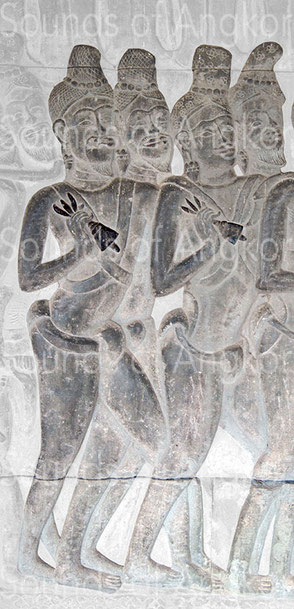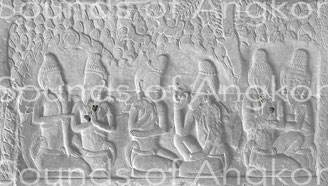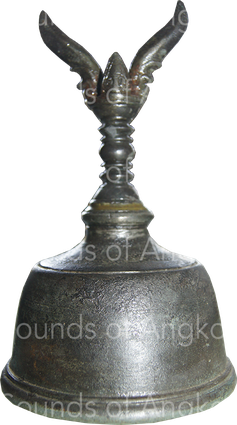Last Update: December 9, 2023
The iconography shows various types of bells of 'open' for differentiated uses: half-vajra bells with internal clapper for the worshipers, bells with external clapper, bells for domestic animals with internal clapper and, on the north gallery of Angkor Wat (12th century section), a large shoulder carried bell with external clapper.
Bells of 'open' through iconography & objects
Among these instruments of power, there are, in the Angkorian period, bells surmounted by a half-vajra, the attribute of the god Indra. In Angkor Wat, in the Historical Parade bas-relief, preceding the litter of the Royal Priest, two Brahmins hold in their right hand a such bell. The Angkorian half vajra consists of five points arranged in a staggered arrangement, depicting the five peaks of Mount Meru described in the Hindu sacred texts. Of profile, only three of the five points are visible. They symbolize the Hindu Trimurti: Brahma, Viṣṇu, Śiva. Another representation of a pair of vajra lightning bells is visible in the southwest corner of this same temple, still in the hands of the Brahmins.
There are two other representations of ritual bells, one in Bayon, very eroded, the other on a bas-relief in Bayon style at the National Museum of Cambodia. In both cases, the bell without vajra is held with the left hand.
Bells of 'open' through epigraphy
The epigraphy of Cambodia mentions the term bell in Sanskrit, ghaṇṭā, whose root has been preserved in the languages of India and in modern Khmer. An occurrence of the 10th century*, in Old Khmer, cites the term katyāṅ and another of the 12th century**, kantiṅ.
In the 10th century, the Sanskrit inscription of Prea Ngouk*** mentions the donation to the temple of a pair of silver bells.
* Cœdès G. 1937 – K.669, IC I, p.170-25.
** BEFEO XLIII, K.194, p.144-18.
*** Barth M.A. 1885 - Notices et extraits des manuscrits de la Bibliothèque Nationale et autres bibliothèques. Inscriptions sanscrites du Cambodge. Tome XXVII, 1er fascicule, P.140.
Large bell of 'open'
A single large bell with external clapper is depicted on the bas-reliefs of the north gallery of Angkor Wat (12th century). Its weight seems considerable considering the position of the two carriers. It is decorated. The percussionist holds a clapper in each hand.
Large bell with external percussion on bearing. Angkor Wat, Battle of Asura and Deva.










